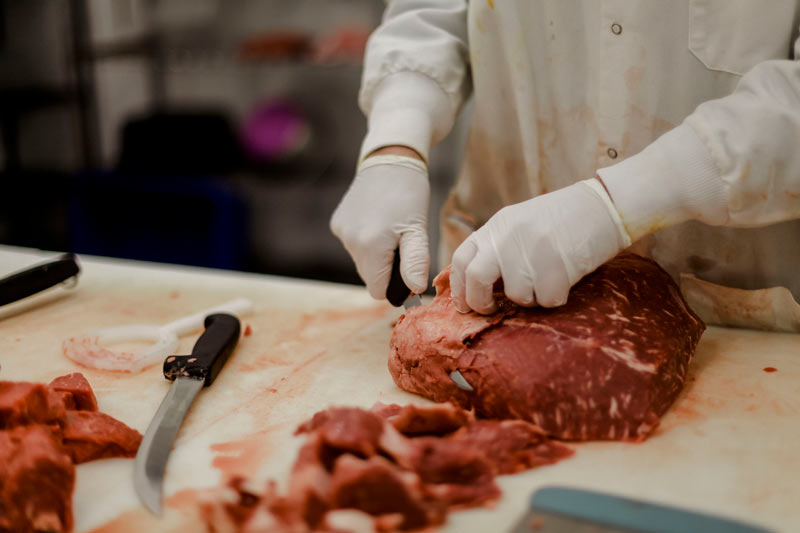Top Factors to Patronize Bagley Farms Meat Market Edwardsville IL for Premium Meats
Top Factors to Patronize Bagley Farms Meat Market Edwardsville IL for Premium Meats
Blog Article
Discover the Art of the Butcher's Cut in a Modern Meat Market
In the ever-evolving landscape of contemporary meat markets, the butcher's cut has actually transcended its standard roots, combining age-old workmanship with contemporary techniques. What genuinely sets the contemporary butcher apart is their ability to build a deeper connection between customers and the origins of their meat.
Advancement of Butchery Methods
The advancement of butchery methods mirrors a rich tapestry of technology and adaptation driven by innovations in innovation, adjustments in consumer need, and a much deeper understanding of meat science. Historically, butchery was a craft gave through generations, with techniques honed over centuries to make the most of return and flavor. Nonetheless, the industrial transformation introduced automation, transforming standard practices and allowing large processing.
The mid-20th century saw butchery methods better refined by scientific understandings right into muscle biology and meat aging, improving both tenderness and preference. Innovations like vacuum packaging and refrigeration prolonged item shelf-life, allowing butchers to diversify offerings and enhance quality assurance. This duration additionally marked the increase of customized tools, such as band saws and meat slicers, which increased precision and effectiveness in meat handling.

Computerized systems currently help in tracking pet provenance and maximizing cuts to satisfy particular customer choices. Furthermore, a resurgence in artisanal butchery has actually emerged, mixing standard skills with modern-day expertise to cater to customers looking for ethical and lasting meat choices.
Understanding Meat Cuts
Recognizing the ins and outs of meat cuts is vital for both butchers and consumers looking for top quality and value. Each cut originates from a different component of the animal, presenting special tastes, structures, and food preparation techniques - bagley farms meat market edwardsville il. Proficiency of these differences not just improves cooking experiences however additionally maximizes the energy of each carcass. For butchers, precise cuts show ability and respect for the craft, making certain minimal waste and ideal return.

Recognizing muscular tissue structure is important; muscle mass made use of a lot more regularly by the pet often tend to be harder and are best fit for slow food preparation approaches, while less-used muscle mass, like those found in the loin, are extra tender and suitable for grilling or roasting. Experience with these distinctions encourages consumers to make enlightened options, enhancing their cooking ventures.
Selecting High Quality Meat
Picking the right meat includes even more than simply picking an aesthetically enticing piece from the screen. The art of picking quality meat needs a critical eye and knowledge of particular qualities that signify freshness and excellence.
Second of all, take into consideration the marbling, which refers to the white flecks of fat within the muscular tissue. Proper marbling is a crucial indication of inflammation and flavor, as it melts throughout food preparation, boosting the meat's juiciness. Remember, higher marbling commonly associates with premium quality cuts, such as USDA Prime.
Structure is one more essential element; meat must really feel strong to the touch, not slimy or excessively soft. Furthermore, bear in mind the aroma. Fresh meat ought to have a tidy, neutral odor, without any type of sour or repulsive smells.
Pairing Cuts With Food Preparation Approaches

Conversely, tougher cuts like brisket and chuck roast are abundant in collagen, which damages down right into gelatin when cooked gradually. These cuts are ideal for braising or sluggish roasting, permitting the meat to soften over time and establish deep, complicated tastes. Similarly, cuts such as short ribs and pork shoulder get on well with slow-cooking approaches, where extended cooking times transform their robust structures right into delicious recipes.
Lamb shanks and oxtail, which call for long term cooking to tenderize, are ideal candidates for stewing or sluggish simmering. These approaches coax out abundant, passionate flavors while maintaining moisture. By comprehending the special features of each cut, cooks and home cooks alike can elevate their culinary creations, guaranteeing each meal is both satisfying and memorable.
The Butcher's Role Today
Navigating the advancing landscape of the contemporary meat market, the butcher's role today expands past mere prep work of cuts. Contemporary butchers are culinary artisans, instructors, and advocates for sustainable techniques. They bridge the void between the ranch and the fork by making sure honest sourcing, understanding pet husbandry, and focusing on transparency in Recommended Reading the supply chain. This change reflects the expanding consumer need for high quality over quantity, where provenance and pet well-being are vital.
In enhancement to crafting exact cuts, butchers now involve directly with clients, offering cooking recommendations and tailoring choices to match private go to this web-site demands and preferences. Their expertise in meat aging, marbling, and flavor accounts empowers consumers to make enlightened decisions, improving their cooking experiences. This customized solution exemplifies the butcher's developing duty as a relied on advisor in the cooking area.
Furthermore, butchers are essential in minimizing waste, using entire pets to create diverse items such as sausages and supplies. This comprehensive technique not only values the animal yet additionally aligns with modern sustainability goals. By doing this, the modern-day butcher personifies both tradition and technology, adjusting to an ever-changing market while protecting the creativity and integrity of their craft.
Final Thought
The contemporary butcher's craft intricately weaves traditional methods with modern-day technologies, highlighting sustainable techniques and ethical sourcing. Mastery in recognizing diverse meat cuts and top quality indicators empowers butchers to give informed suggestions, aligning details cuts with optimum food preparation methods. This proficiency not only boosts culinary experiences but also enhances the connection between consumers and the origins of their food. By honoring historical techniques while embracing contemporary demands, the butcher's role continues to be essential in today's advanced meat market (bagley farms meat market edwardsville il).
Report this page